
Lupine Publishers Group
Lupine Publishers
Menu
ISSN: 2637-4544
Research Article(ISSN: 2637-4544) 
Audiological Characteristics of Individuals with Hearing Loss in Otolaryngology Setup: a Retrospective Study in India Volume 1 - Issue 4
Tulsi Sao, A Navya* and Kavita Sachdeva
- Department of Audiology, All India Institute of Speech & Hearing, India
Received: March 12, 2018; Published: March 20, 2018
Corresponding author: A Navya, Department of Audiology, All India Institute of Speech & Hearing, India
DOI: 10.32474/IGWHC.2018.01.000119
Abstract
Introduction: Hearing loss is hidden disability. Audio logical characteristics of hearing loss varies depending on age, gender, geographical location, socioeconomic status, occupational and other causative factors may interact with each other.
Aim: The present study aimed at exploring the audio logical characteristics of patients across the age range in both males and females receiving services at Department of ENT at Netaji Subhash Chandra Bose Medical College, India: A retrospective study.
Method: A retrospective case analysis was carried out by reviewing 1189 registered cases of those who received services from department of ENT at NSCB Medical College. The details of age, gender, degree, type of hearing loss, and management were obtained.
Result: The results indicated that 30% of the patients reported with complaints related to hearing were in the age range of 1829 years and only 7% were below 14 years. Among these 60.8% were males and 39.1 % were females. The majority of patients were exhibiting moderate (21%) hearing loss followed by mild (18.2%). A significant number of patients (18.4%) do exhibited normal hearing sensitivity. The type of the hearing loss in majority of these patients is conductive hearing loss (48.3%) exhibiting flat configuration (64.2%) in the audiogram. Hence, most of these patients underwent medical/surgical treatment (73.8%) to avoid the spread of infection or disease further. Some of the patients with irreversible hearing loss were recommended for hearing aid usage (20.9) and cochlear implantation (5%).
Conclusion: The study focuses on highlighting the details of various patients reporting to an otolaryngology set up exhibiting different type and degree of hearing loss and the respective treatment suggested and team work of an otolaryngologist and audiologist. The study also concludes that awareness need to be increased among public to identify children with mild and moderate hearing loss as the number of children reporting to the clinic are very less compared to the adults. Early intervention has major role in developing the speech and language skills of the children.
Introduction
Hearing loss is hidden disability [1]. Hearing impairment is a broad term that refers to hearing losses of varying degrees ranging from hard-of-hearing to total deafness [2]. Audio logical characteristics are defined based on types, degree, and configuration of hearing loss [3]. Otolaryngologist (ENT) is a medical health care professional who treat the diseases related to the ear, nose, and throat. In otolaryngology setup, the major role is to diagnose and treat diseases of the ears, nose, mouth and throat. An audiologist is a licensed hearing healthcare professional who specializes in the diagnosis and treatment of hearing loss and balance disorders in adults and children.
The prevalence of hearing loss varies with respect to age, gender, types of ear diseases, degree of hearing loss, geographical location and other causative factors may interact each other [4,5]. The prevalence of congenital hearing loss has been estimated to be 1.25.7 per thousand in neonates [6,7] and more in high risk neonates. The research reports 14.9% prevalence of hearing loss in 6-19 years children [8] and 5 per1000 in 3-17 years children [9]. However, the greater prevalence of hearing loss was reported 45.9% [4] and 50-65% in older adult in western country. Thus, the prevalence of hearing loss is fivefold higher in elders than younger population [10]. Studies reported that male and female ratio of hearing losses increases with age [11,12]. Thus, hearing loss is more common in older males than females. Otitis media is one of the most common cause of conductive hearing loss in western country [13]. The prevalence of conductive hearing loss in children below 6 years of age due to otitis media was found to be 9.2% in India & Nigeria, 9.1% in Iran, 6.7% in China and 5.1-7.8% in Russia [14]. In Indian studies, 17.6% school age children have otitis media, 53.4% have conductive hearing loss associated with other middle ear diseases and 91.2% children found to be having mixed hearing loss [15]. However, the higher prevalence of conductive hearing loss (81.6%) reported in children who belongs to lower economic status [16]. The prevalence of sensorineural hearing loss is higher in Asian children (5.09 to 9.61 per 1000) than non-Asian children (1.4 to 3.51 per 1000) [17]. The prevalence of congenital sensorineural hearing loss is 1:2000 reported in American countries [18]. The total prevalence of hearing loss was 21.04 % reported in district of Lucknow, India [19]. Thus, from the above evidences, it may conclude that several studies have reported different prevalence rate and audio logical characteristics of hearing loss. Thus, the current study aimed at profiling of audio logical characteristics of individuals with hearing loss who reported at an otolaryngology setup.
Method and Procedures
A retrospective study was carried out to explore the audio logical characteristics of patients by reviewing the case records of those who visited to speech and hearing unit department of ENT, Netaji Subhash Chandra Bose Medical College, Jabalpur (Madhya Pradesh) from January 2015 to December, 2016. In register based analysis, the details of age, gender, diagnosis, degree, type, and patterns of hearing loss were obtained.
Degree of hearing loss: Goodman's classification (1965) [20] was used to classify degree of hearing loss.
Types of Hearing loss: The types of hearing loss for the subject profiled were done on the basis of both air and bone conduction threshold and air bone gap (ABG). The subject whose both air and bone conduction thresholds were affected and the ABG less or equal to 10dB were classified as sensorineural hearing loss. The subject whose air conduction threshold was affected and with normal bone conduction thresholds were classified as conductive hearing loss and the subject whose both air and bone conduction threshold were affected with (ABG) more than 10 dB were classified as having mixed hearing loss [3].
Configuration of hearing loss: The subjects were diagnosed as flat, rising, sloping, trough (Scoop), inverted scoop (saucer), and fragmentary /corner, 4 KHz notch and high frequency hearing loss [21] (Roeser, Valente, Hosford-Dunn, 2007).
Instrumentation: Pure tone audiometry (Piano Inventis), Immitance audiometry (Maico Easytymp pro), Otoacoustic emission (Mimosa Diagnostic OAE) and ABR Bio-logic Natus pro (ver 7.2.1) were used for diagnostic evaluation. All tests were performed in sound treated room in which ambient noise levels were well within the permissible limits as per ANSI S3.1, 1991 standards [22].
Statistics: The SPSS 17 version software was used for statistical analysis of data. The data is analysed using descriptive statistical analysis.
Results
The data on total number of 1189 patients who reported to speech and hearing unit at department of ENT from the period of 2015 to 2016 in the age range of 1 day to 90 years were statistically analyzed. Age: From the total number of 1189 patients with hearing loss, 30% were between 18-29 years, 20 % were between 61-90 years, 7% were below 14 years and only l.3% were below 5 years. Gender: Among the patients with hearing loss, 60.8% were males and 39.1 % were females as shown in (Figure 1).
Figure 1: Gender differences in clients reported with hearing loss.
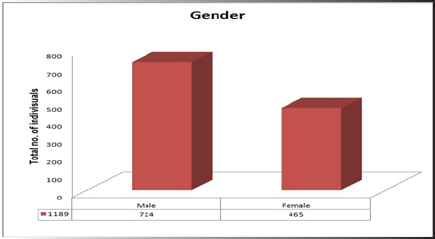
Degree of hearing loss: Majority of individuals with hearing loss in right ear exhibited moderate hearing loss (21%), followed by mild (18.2%) and moderately severe (16.2%) hearing loss. The least number of individuals exhibited profound (5.7%) hearing loss.In fact, many individuals do exhibited normal hearing (18.4%) also (Figure 2). The severity of hearing loss in left ear is also exhibiting similar patterns.
Figure 2: The distribution of degree of hearing loss.

Types of hearing loss: Highest number of individuals on right ear had conductive hearing loss (48.3%) followed by sensorineural hearing loss (33.7%). The (Figure 3) depicts that least number of individuals exhibited mixed hearing loss (17.9). Similar pattern of type of hearing loss was exhibited on left ear also.
Figure 3: The distribution of degree of hearing loss.
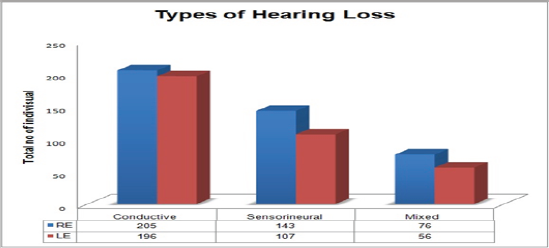
Configuration of hearing loss: Greater number of individuals with hearing loss exhibited flat configuration of hearing loss (64.2%) followed by slopping pattern (26.9%). All the other pattern of hearing loss such as raising (2.4%), trough(1.3%), saucer (0.5), corner (2.9), high frequency(1.1), 4KHz notch (0.2) were mere.
Management/ treatment: Most of the patients around 73.8% were treated with medical or surgical treatment. The patients (20.9%) who do not benefit from medical treatment are recommended for hearing aids. However, few patients (5.2) with mixed hearing losses were initially treated medically for conductive pathologies and later recommended for hearing aids. Children (5%) with congenital severe to profound losses were recommended for cochlear Implantation.
Discussion
The present study outlines audio logical characteristics of individuals with hearing loss in ENT setup in India. In the current study, total number of 1189 many individuals with hearing related complaints who got registered in the period from January 2015 to December, 2016 were reviewed. The results revealed that major number of individuals with hearing complaints were from 18 to 29 years. It may be due to otitis media is one of the most common cause of conductive hearing loss which increased in the age group of 20-30 years [23]. Hearing loss is grossly neglected especially in children belongs in rural population in India [24] which increases the risk of low performance in speech and education with increasing age [25]. Thus, greater number of individuals with hearing impairment were between 18-29 years. The results also indicated a significantly high number of elderly population with at the clinic with hearing complaints than children The greater number of individual with older adult with hearing impaired was visited at as age induced hearing loss also called presbycusis; resulting sensorineural hearing loss [4].
In the present study, it was found that prevalence of hearing loss was more in male than females (Figure 1). It may be due to more number of CSOM (Chronic suppurative otitis media) resulting conductive hearing loss, were visited in otolaryngology setup. Previous studies reported that higher prevalence of CSOM in males than female [26,27]. In other studies, it was also reported that males and females ratio of hearing loss increases with age. Thus, prevalence of hearing loss is more in older males than females [28]. This could be attributed to larger pneumatization area of mastoid among females [29] and difference in endocrine immune interaction resulting males to be more susceptible to infection [30].
The results also indicated that conductive hearing loss is more prevalent than mixed and sensorineural types of hearing loss in otolaryngology setup (Figure 3). It could be because major number of individuals initially has conductive hearing loss, when it is not treated then it can get spread from middle ear to inner ear resulting causing damage to the sensory hair cells too. Then this condition will turn to become mixed hearing loss.
Regarding the degree of loss the results indicated that mild to moderate degree of hearing loss is more prevalent in current study than profound degree of hearing loss (Figure 2). It may be because of more number of individuals with conductive hearing loss. Conductive hearing loss impedes conduction of sound which create air bone gap of maximum 60dBHL. In general, the congenital hearing losses most often to be of severe to profound degree (Figure 4-6).
Figure 4: Indicated age range of clients reported as hearing loss.
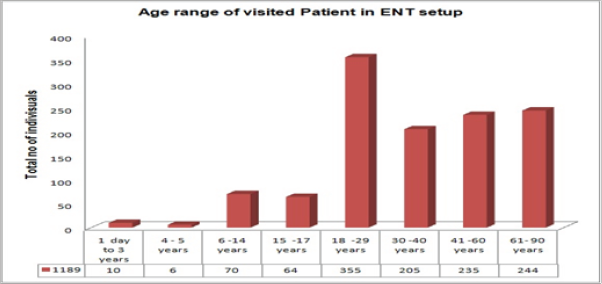
Figure 5: The distribution of configuration of hearing loss.
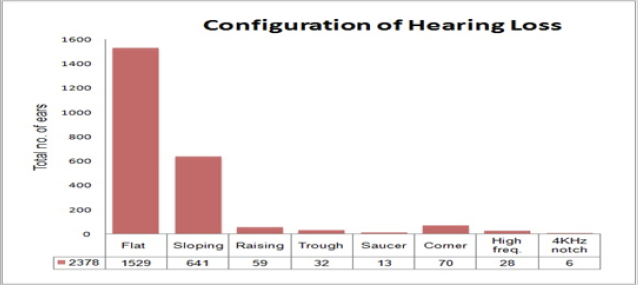
The management of hearing loss can be of medical/ surgical treatment, providing amplification devices such as hearing aid, cochlear implantation (CI), bone conduction hearing aid, bone anchored hearing aid (BAHA), middle ear implant (MEI), auditory brainstem implant (ABI) midbrain implant (AMI). In the present study, most of the patients underwent medical/ surgical treatment as more no of cases have conductive hearing loss. Hence medical/ surgically treatment is better option to control the spread of infection. Sensorineural hearing loss cases were recommended for fitting hearing aid, determine the candidacy of cochlear implant and disability certification purpose. In individuals with mixed hearing loss initially medical treatment followed by use of amplification was recommended (Table 1).
Figure 6: Management of hearing loss.
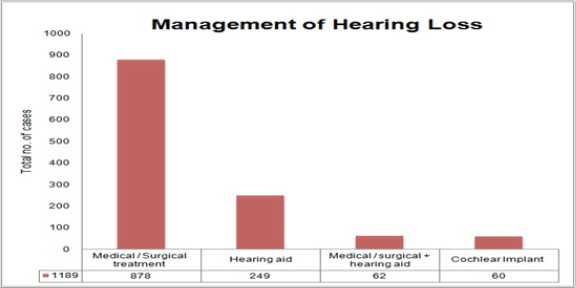
Table 1:
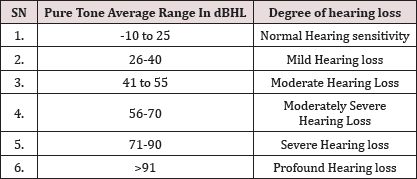
Conclusion
The present study focused on audio logical characteristics of individual with hearing loss in ENT setup: a retrospective study in India. The hearing loss was more in adults than elderly population and more in males than females. Conductive hearing loss is more prevalent than mixed and sensorineural types of hearing loss. In terms of degree of loss, mild to moderate degree of hearing loss were more prevalent than profound degree of loss in current study. No drug therapy exits for sensorineural hearing loss but early identification and intervention can facilitate development of communication. Thus, the study highlight the various types, degree of hearing loss and the management options availed by the patients from a team of professionals consisting of otolaryngologist and audiologist at a hospital setup. Furthermore the present study emphasizes the team work of an audiologist and the otolaryngologist in diagnostic formulation and planning the appropriate management. The study also concludes that awareness need to be increased among public to identify children with mild and moderate hearing loss as the number of children reporting to the clinic are very less compared to the adults. Early intervention has major role in developing the speech and language skills of the children.
References
- Mackenzie I & Smith A (2009) Deafness-the neglected and hidden disability. Ann Trop Med Parasitol 103(7): 565-571.
- Smith RJ, Shearer AE, Hildebrand MS, Van Camp G (2014) Deafness and hereditary hearing loss overview. Essentials of audiology New York, USA: Thieme 2001.
- Cruickshanks KJ, Wiley TL, Tweed TS, Klein BE, Klein R, et al. (1998) Prevalence of hearing loss in older adults in Beaver Dam, Wisconsin the epidemiology of hearing loss study. Am J Epidemiol 148(9): 879-886.
- Helzner EP, Cauley JA, Pratt SR, Wisniewski SR, Zmuda JM, et al. (2005) Race and sex differences in age-related hearing loss: The Health, Aging and Body Composition Study. J Am Geriatr Soc 53(12): 2119-2127.
- Parving A (1993) Congenital hearing disability: epidemiology and identification-a comparison between two health authority districts. Int J Pediatr Otorhinolaryngol 27: 29-46.
- Kim SY, Bothwell NE, Backous DD (2002) The expanding role of the otolaryngologist in managing infants and children with hearing loss. Otolaryngol Clin North Am 35(4): 699-710.
- Niskar AS, Kieszak SM, Holmes A, Esteban E, Rubin C, et al. (1998) Prevalence of hearing loss among children 6 to 19 years of age: The Third National Health and Nutrition Examination Survey. JAMA 279(14): 1071-1075.
- Boulet SL, Boyle CA, Schieve LA (2009) Health care use and health and functional impact of developmental disabilities among.com children, 1997-2005. Arch Pediatr Adolesc Med 163(1): 19-26.
- Agrawal Y, Platz EA, Niparko JK (2008) Prevalence of hearing loss and differences by demographic characteristics among.com adults: data from the National Health and Nutrition Examination Survey, 1999-2004. Arch Intern Med 168(14): 1522-1530.
- Feder K, Michaud D, Ramage-Morin P, McNamee J, Beauregard Y (2015) Prevalence of hearing loss among Canadians aged 20 to 79: Audiometric results from the 2012/2013 Canadian Health Measures Survey. Health Rep 26(7): 18-25.
- Gates GA, Cooper JC Jr, Kannel WB, Miller NJ (1990) Hearing in the Elderly: The Framingham Cohort, 1983-1985: Part 1. Basic Audiometric Test Results. Ear Hear 11(4): 247-256.
- Davidson J, Hyde ML, Alberti PW (1987) Epidemiology of hearing impairment in childhood. Scand Audiol Suppl 30: 13-20.
- DeAntonio R, Yarzabal JP, Cruz JP, Schmidt JE, Kleijnen J (2016) Epidemiology of otitis media in children from developing countries: A systematic review. Int J Pediatr Otorhinolaryngol 85: 65-74.
- Jacob A, Rupa V, Job A, Joseph A (1997) Hearing impairment and otitis media in a rural primary school in South India. Int J Pediatr?
- Rao RP, Subramanyam MA, Nair NS, Rajashekhar B (2002) Hearing impairment and ear diseases among children of school entry age in rural South India. International journal of pediatric otorhinolaryngology 64(2): 105-110.
- Naeem Z, Newton V (1996) Prevalence of sensorineural hearing loss in Asian children. Br J Audiol 30(5): 332-339.
- Fisch L (1973) Epidemiology of congenital hearing loss. Audiology 12(5- 6): 411-425.
- Mishra A, Verma V, Shukla GK, Mishra SC, Dwivedi R (2011) Prevalence of hearing impairement in the district of Lucknow, India. Indian J Public Health 55(2): 132-134.
- Goodman AC (1965) Reference zero levels for pure-tone audiometers. Asha 7: 262-263.
- Roeser RJ, Valente M, Hosford-Dunn H (2007) Auditory diagnosis. Thieme.
- (1999) American National Standards Institute (ANSI). Maximum permissible ambient noise levels for audiometric test rooms. ANSI, New York, USA, S3: 1-1999.
- Surjan L, Devald J, Palfalvi L (1973) Epidemiology of hearing loss. Audiology 12(5-6): 396-410.
- Varshney S (2016) Deafness in India. Indian Journal of Otology 22(2): 73-76.
- Kim CS, Jung HW, Yoo KY (1993) Prevalence and risk factors of chronic otitis media in Korea: results of a nationwide survey. Acta Otolaryngol 113(3): 369-375.
- Akinpelu OV, Amusa YB, Komolafe EO, Adeolu AA, Oladele AO (2008) Challenges in management of chronic suppurative otitis media in a developing country. J Laryngol Otol 122(01): 16-20.
- Jensen RG, Hom0e P, Andersson M, Koch A (2011) Long-term follow-up of chronic suppurative otitis media in a high-risk children cohort. Int J Pediatr Otorhinolaryngol 75(7): 948-954.
- Faden H, Duffy L, Wasielewski R, Wolf J, Krystofik D(1997) Relationship between nasopharyngeal colonization and the development of otitis media in children. J Infect Dis 175(6): 1440-1445.
- Tos M, Stangerup SE (1985) Secretory otitis and pneumatization of the mastoid process: sexual differences in the size of mastoid cell system. Am J Otolaryngol 6(3): 199-205.
- Klein SL (2000) Hormones and mating system affect sex and species differences in immune function among vertebrates. Behav Processes 51(1-3): 149-166.

Top Editors
-

Mark E Smith
Bio chemistry
University of Texas Medical Branch, USA -

Lawrence A Presley
Department of Criminal Justice
Liberty University, USA -

Thomas W Miller
Department of Psychiatry
University of Kentucky, USA -

Gjumrakch Aliev
Department of Medicine
Gally International Biomedical Research & Consulting LLC, USA -

Christopher Bryant
Department of Urbanisation and Agricultural
Montreal university, USA -

Robert William Frare
Oral & Maxillofacial Pathology
New York University, USA -

Rudolph Modesto Navari
Gastroenterology and Hepatology
University of Alabama, UK -

Andrew Hague
Department of Medicine
Universities of Bradford, UK -

George Gregory Buttigieg
Maltese College of Obstetrics and Gynaecology, Europe -

Chen-Hsiung Yeh
Oncology
Circulogene Theranostics, England -
.png)
Emilio Bucio-Carrillo
Radiation Chemistry
National University of Mexico, USA -
.jpg)
Casey J Grenier
Analytical Chemistry
Wentworth Institute of Technology, USA -
Hany Atalah
Minimally Invasive Surgery
Mercer University school of Medicine, USA -

Abu-Hussein Muhamad
Pediatric Dentistry
University of Athens , Greece

The annual scholar awards from Lupine Publishers honor a selected number Read More...















